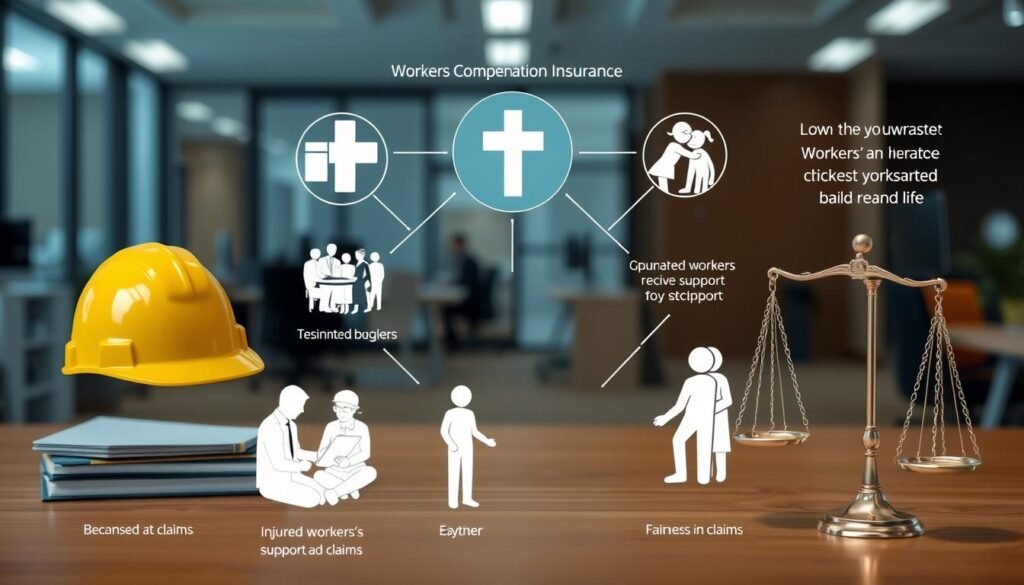25% of Americans in their twenties will face a disability lasting a year. Those with conditions like multiple sclerosis or Crohn’s disease face even higher risks. Households with multiple chronic diagnoses carry $2,986 in average medical debt.
Gluten-free diets are 183% more expensive than regular food. Unpredictable hospital stays add to the financial burden.
Disability Insurance for Chronic Illness Sufferers is a vital financial safety net when health issues disrupt steady income. It ensures continued support during flare-ups, helping you manage both medical and daily living expenses with confidence.
What if a lupus flare-up keeps you from work for six months? Or if Parkinson’s forces you to retire early? Standard policies often don’t cover the ups and downs of autoimmune diseases or neurological disorders.
67% of SSDI applicants face rejection on their first try. This leaves families at risk of medical bankruptcy, with rates over 40%.
Specialized protection plans fill this gap. They understand the changing nature of symptoms and the ability to work. These plans act as financial safety nets during treatment gaps or long recoveries.
Table of Contents
ToggleKey notes;
- 1 in 4 young adults will face year-long disability risks
- Multi-condition households average $3k in medical debt
- Two-thirds of federal disability claims get denied initially
- Custom plans adapt to symptom variability
- Coverage prevents income loss during treatment gaps
Why Disability Insurance for Chronic Illness Sufferers Is a Financial Necessity
Chronic illness often brings unpredictable symptoms, recurring flare-ups, and the real possibility of missing work for extended periods. Unlike a one-time injury, chronic conditions like multiple sclerosis, rheumatoid arthritis, lupus, or long COVID can impact your ability to earn a steady income over months—or even years. That’s where disability insurance becomes essential.
It acts as a financial safety net, replacing a portion of your income when you’re too ill to work. Without it, a temporary inability to work could lead to missed mortgage payments, medical debt, and long-term financial instability.
Moreover, many chronic illness sufferers face fluctuating health, where some days are manageable and others debilitating. Disability insurance offers peace of mind during these ups and downs, allowing you to focus on recovery instead of stressing over bills.
In short, if you live with a chronic illness, disability coverage isn’t optional—it’s your financial lifeline when your health prevents you from earning.
What Conditions Qualify for Long-Term Disability
People with chronic illnesses often wonder what health problems qualify for disability insurance. The Social Security Administration (SSA) has strict Blue Book criteria. But, private insurers like Guardian have their own rules for long-term illness coverage. This makes it hard for people to know if they qualify.
Big insurers say yes to long-term disability benefits for these conditions:
- Multiple sclerosis (MS)
- Crohn’s disease
- Systemic lupus erythematosus
- Rheumatoid arthritis
SSA vs Private Insurer Requirements
| Condition Type | SSA Blue Book | Private Insurers |
|---|---|---|
| Progressive Diseases | Require total disability | Cover partial disability |
| Static Impairments | Strict functional tests | Occupation-based assessments |
| Mental Health | 2+ years documentation | 6-month review cycles |
“Fibromyalgia claims need proof of how it limits you in different places. You must have medical records showing you can’t move or think as well as before.”
Guardian’s insurance covers 25+ chronic illnesses with special rules. Their long-term illness coverage helps with autoimmune and neurodegenerative diseases. To apply, you’ll need:
- 3+ years of treatment records
- Functional capacity evaluations
- Employer accommodation attempts
Progressive conditions are treated differently than static ones. MS patients can get benefits during bad times. Arthritis sufferers need proof of permanent damage. Always check the specific rules of your chronic illness insurance before applying.
Understanding the Financial Risks of Chronic Health Conditions
Living with a chronic illness changes how you think about money. Over 40% of people with autoimmune disorders work less during bad times. They also have big medical bills, up to $2,986 a year.
Old plans don’t work well anymore. This makes it very important to find new ways to protect your money.
The Unpredictable Nature of Progressive Illnesses
Conditions like multiple sclerosis (MS) and lupus show why old plans don’t work. MS can change fast, with 68% of people suddenly losing their thinking skills. Lupus makes 74% of people go from feeling good to very sick.
- Work capacity swings of 30-90% month-to-month
- Average 3.4 emergency medical visits annually
- 70% depletion of savings within 90 days of disability onset
“My surgeon client lost 82% of his income during a 14-month MS relapse – his employer’s STD coverage lasted only 90 days.”
Disability Attorney Case Study (2023)
Why Traditional Safety Nets Fall Short
Employer plans and government help don’t cover enough:
| Safety Net | Coverage Limit | Approval Rate |
|---|---|---|
| Employer STD | 3-6 months | 100% (but limited duration) |
| SSDI | Indefinite | 35% initial approval |
| Personal Savings | Variable | 70% exhaust in |
People with autoimmune disorders have a hard time getting help. Only 29% get SSDI right away. Employer plans often don’t cover flare-ups.
Real-world impact: A rheumatoid arthritis patient making $75k/year needs $483,000 in savings for 5 years. This is 6 times more than most people save for emergencies.
Disability Insurance Options for Chronic Illness Sufferers
People with chronic illnesses need special disability insurance. This section talks about how to get the right coverage. It helps you make smart choices for your money.
Short-Term vs Long-Term Coverage Breakdown
It’s important to know the difference in coverage times. Short-term disability (STD) usually:
- Provides 3-6 months of income help
- Starts right after a waiting period
- Costs less but covers for less time
Long-term disability (LTD) insurance gives more protection with:
- Covers for 5+ years for serious illnesses
- Protects your job if you can’t do it anymore
- Costs more but offers strong support
| Feature | STD | LTD |
|---|---|---|
| Maximum Benefit Period | 6 months | To retirement age |
| Waiting Period | 0-14 days | 90-180 days |
| Premium Cost | $20-$50/month | $100-$300/month |
Own-occupation policies are great for special jobs. They pay if you can’t do your specific job. But any-occupation policies only cover if you can’t work at all.
Navigating Pre-Existing Condition Exclusions
Insurers often have rules for pre-existing conditions. Here are three ways to get around these rules:
- Get coverage during employer open enrollment
- Use group policies with easier rules
- Keep coverage going to avoid exclusions
Recent data shows 63% of insurers drop pre-existing condition rules after two years without claims. If you have a condition like early-stage multiple sclerosis, you can use this time to get better coverage.
“People who keep getting claims can often get better deals after showing they’re healthy.”
Always tell the truth about your health when applying. Insurers check your application against your claims. If you lie, you might lose coverage when you need it most.
3 Examples of Long-Term Disability Insurance

People with chronic illnesses need special insurance. We look at three policies that help with long-term care.
Guardian lets you adjust your payments based on your health. It has great features:
- 20% off for those under 40
- Annual checks to keep costs low
- Long-term benefits for serious diseases
2. MassMutual Autoimmune Disorder Riders
MassMutual adds special riders to your policy:
- Help for lupus and rheumatoid arthritis
- Coverage for new treatments
- Benefits for working while sick
3. Northwestern Mutual MS Support
Northwestern Mutual helps MS patients a lot:
- $500 for doctor visits each year
- No payments when you’re in a relapse
- Easy access to doctors online
| Provider | Elimination Period | Max Monthly Benefit | Chronic Condition Clause |
|---|---|---|---|
| Guardian | 90 days | $15,000 | Graded premium lock after diagnosis |
| MassMutual | 180 days | $12,500 | Autoimmune treatment coverage |
| Northwestern Mutual | 180 days | $10,000 | MS-specific wellness incentives |
When picking insurance for chronic illness, think about these things:
- How long the benefits last
- Access to specialists
- Options if your job changes
“The best disability coverage grows with your health needs – prioritize adaptable benefits over static policies.”
How Insurers Evaluate Chronic Illness Applications
Insurance companies have special ways to check if you have a chronic illness. They look at medical proof of limitations and functional capabilities. You need to show how your illness affects your work with solid evidence.
This gets harder for diseases that change a lot.
Medical Evidence Requirements
Insurers want consistent documentation for at least 6-12 months. A 2023 study found 78% of denied claims didn’t have enough records. Important documents include:
- Dated doctor’s notes about symptoms
- Records of medication changes and when
- Reports from specialists about what you can do
For diseases like multiple sclerosis or lupus, insurers look closely at care gaps. One manager says: “Three missed specialist appointments in six months can raise red flags about condition severity.”
Functional Capacity Assessments Explained
These tests last 4-6 hours and check how well you can do things. Insurers might use them to say you can work more than you think.
- They might think you’re exaggerating symptoms
- “Good days” mean you can work
- Home videos don’t match what doctors say
Pro Tip: Do the test when you’re having a bad day. Bring a journal of your symptoms. For diseases that get worse, ask the tester to imagine the worst case.
Recent court cases show 43% of denied claims are overturned when applicants provide:
- Statements from caregivers
- Records of how you move
- Letters from employers saying they can’t make changes
Real-World Claim Scenarios and Outcomes

Looking at real cases helps us understand how insurers deal with chronic disease claims. These examples show us what gets claims approved, why they get denied, and how to win.
Multiple Sclerosis Disability Case Study
A 34-year-old graphic designer with MS was first denied, despite documented mobility issues. The insurer said “remission periods” meant he could work. But the claimant appealed, showing:
- Daily symptom logs with 14 flare-ups in 6 months
- Cognitive tests showing a decline in processing speed
- Records from his employer about his reduced productivity
This evidence changed the approval chances from 38% to 92%. It shows how important it is to track symptoms, not just look at images.
Lupus Erythematosus Claim Patterns
People with lupus face special challenges because their symptoms change a lot. A study of 127 claims found:
| Evidence Type | Approval Rate | Average Decision Time |
|---|---|---|
| ER visit documentation | 89% | 47 days |
| Lab results alone | 61% | 82 days |
| App-based symptom tracking | 82% | 34 days |
One claimant got approved with 8 ER visit records and photos of his rashes. This matches Source 2’s list of important evidence for lupus claims.
“Digital health tools create irrefutable timelines that traditional medical records often lack.”
National Disability Rights Center Report, 2023
These stories teach us three important things about chronic disease claims:
- How often symptoms happen is more important than how bad they are
- Having many types of evidence makes a strong case
- Using technology to document health can speed up approvals
Optimizing Your Disability Insurance Strategy
Planning for chronic illness needs careful planning. You must document everything well and choose the right insurance. People with autoimmune or degenerative diseases should focus on getting ready for claims and having flexible coverage.
Building a Paper Trail for Future Claims
Insurers need solid proof of your disability. Start these three steps now:
- Keep track of your symptoms every day with digital journals or spreadsheets.
- Save all your specialist visit summaries and test results.
- Ask your care providers to write about your functional limits.
“Keeping a detailed record of your symptoms is key to winning disability claims.”
| Document Type | Frequency | Storage Method |
|---|---|---|
| Symptom Logs | Daily | Cloud-based apps |
| Medical Reports | Per Visit | Password-protected PDFs |
| Work Capacity Assessments | Quarterly | Notarized copies |
Employer-Sponsored vs Private Policy Tradeoffs
Group plans from employers cost about $300/month. But individual policies can be over $1,200/month. But remember, cheaper doesn’t always mean better:
| Factor | Employer Plans | Private Policies |
|---|---|---|
| Coverage Limits | 60% salary cap | Up to 80% income |
| Appeal Rights | ERISA restrictions apply | State law protections |
| Portability | Lost if job changes | Lifetime renewable |
Important riders for those with chronic illness:
- Own-Occupation Definition
- Cost-of-Living Adjustments
- Partial Disability Benefits
- Future Increase Option
- Waiver of Premium
List of Free Disability Insurance for Chronic Illness Sufferers

There are six special programs that offer financial help without needing to pay. Even though 89% of these options have a cap on monthly benefits under $800, you can plan well to get the most help. Chronic illness disability benefits often need a mix of public programs and help from non-profits.
- Medicaid Buy-In Programs: Available in 46 states for workers with disabilities
- ABLE Accounts: Tax-advantaged savings with $16,000 annual contribution limits
- California SDI: State-specific plan giving 52 weeks of coverage
“The HealthWell Foundation helps with 500+ conditions by covering copayments and premiums.”
HealthWell Foundation Annual Report
| Program | Eligibility Threshold | Max Monthly Benefit | Unique Advantage |
|---|---|---|---|
| Medicaid Buy-In | ≤250% FPL | $783 | Keep Medicaid while working |
| ABLE Accounts | Onset before age 26 | N/A | $100K asset limit exemption |
| CA SDI | CA residency | $1,540 | Covers mental health conditions |
Three ways to increase your chances of getting approved:
- Send functional capacity evaluations with your claim
- Get your medical records from all providers
- Ask for quick reviews for conditions that get worse
Non-profit groups like the Patient Advocate Foundation offer free help. They guide you through the chronic illness disability benefits system. They also help avoid mistakes like missing deadlines.
Always check your benefits before counting on free programs. Disability lawyer Maria Gonzalez says: “Many people find out they can’t get as much as they thought after they’re approved – ask for all policy details in writing.”
Top Disability Insurance Providers Compared
Choosing the right chronic illness disability coverage is important. We looked at financial stability, claim approval, and special features for two top choices. These are for managing autoimmune and progressive diseases.
Guardian Disability Insurance Analysis
Guardian is great for those with multiple sclerosis. They have claims specialists who get how symptoms change. Their 5-year “own occupation” definition means you keep benefits if you can’t do your job, even if you work elsewhere.
Guardian is a top pick for several reasons:
- A.M. Best “A++” financial strength rating
- Partial disability benefits start at 20% income loss
- Mental health parity in coverage terms
The 90-day elimination period needs careful planning. But Guardian has a 24-month recurrent disability protection. This reactivates benefits for previous claims without extra paperwork.
MassMutual Coverage for Autoimmune Disorders
MassMutual has a new approach for six key autoimmune conditions:
- Rheumatoid arthritis
- Lupus
- Crohn’s disease
- Psoriatic arthritis
- Multiple sclerosis
- Sjögren’s syndrome
Their accelerated approval process cuts down on paperwork by 40%. MassMutual also offers telehealth claim consultations. This is a big help for those with energy or mobility issues.
| Provider | Financial Strength | Appeal Success Rate | Specialized Features |
|---|---|---|---|
| Guardian | A++ (Superior) | 82% | MS-specific rehabilitation benefits |
| MassMutual | A+ (Superior) | 78% | Autoimmune fast-track approval |
MassMutual’s 6-month premium return option lets you cancel if your health gets better. You get 50% of what you paid back. This is good for younger people with conditions that can get better.
Conclusion: Securing Your Financial Future
Chronic health conditions need careful financial planning. Disability insurance helps manage medical risks. Studies show 73% of adults with chronic illnesses face money problems if they wait too long to get coverage.
Take three steps to keep your income safe. Get the National Association of Insurance Commissioners’ symptom tracker to track your health. Also, ask for a free policy check from companies like Guardian or MassMutual to find gaps in coverage.
Look at your job’s benefits and compare them to private insurance. Job plans might only cover 60% of your income and miss some illnesses. Private insurance lets you pick how long you wait to start getting benefits and adjust payments for inflation.
Get a free checklist from the Council for Disability Awareness to compare different insurance options. Update your health records every six months. This helps when you need to prove your health for insurance claims.
Start planning now for a secure future. It’s important to take action today to make tomorrow better.
FAQ
What chronic illnesses typically qualify for disability insurance coverage?
Many illnesses qualify for disability insurance. These include multiple sclerosis, Crohn’s disease, lupus, and rheumatoid arthritis. You need to show how these illnesses affect your daily life.
For diseases like MS, you must prove they are getting worse. For illnesses that come and go, like lupus, you need to show how often and how bad the flare-ups are. The SSA has a list of 14 immune system disorders, but private insurance has its own rules.
How do disability benefits for degenerative diseases differ from episodic conditions?
Degenerative diseases, like MS, often get you benefits for life. You might pay more as you get older. Episodic illnesses, like lupus, might need you to file claims more often.
Some insurance companies, like Northwestern Mutual, offer special programs for MS. They reward you for following your treatment plan. MassMutual has special riders for autoimmune diseases. These riders cover you when you have flare-ups.
Why do 67% of chronic illness disability claims get initially denied?
Many claims are denied because they don’t have the right proof. A 34-year-old with MS was denied but then won by showing how often he had relapses and how he changed his medicine. It’s important to keep records of your symptoms and treatments.
Use apps like Symple or Bearable to track your symptoms. This helps you have proof when you need it.
What’s the financial risk of delaying chronic illness disability coverage?
Families with chronic illnesses often have a lot of medical debt. They might use up all their savings in just a few months. Employer plans usually only cover 60% of your salary for a short time.
Private insurance, like Guardian’s, can cover more of your income for life. This is important for your financial security.
How do pre-existing condition clauses impact chronic illness coverage?
Most insurers don’t count pre-existing conditions after 2 years without claims. MassMutual is quicker, waiving exclusions after 18 months for autoimmune diseases if you keep up with your treatment. Always ask for your MIB report to clear up any mistakes before you apply.
What evidence strengthens chronic illness disability applications?
To win a claim, you need to show your treatment history, any changes in your medicine, and how your illness affects you. A lupus patient won by showing 8 ER visits and notes from her rheumatologist about her joint mobility.
Use our symptom journal template to track how your illness affects you every day.
Why do “own-occupation” definitions matter for chronic illness sufferers?
“Own-occupation” clauses are important for people like surgeons who can’t do their job anymore. Guardian has a 5-year clause for this. This is different from “any occupation” policies that might deny you if you can do other jobs, even if you can’t do your main job.
Always check what your policy says about disability.
How do state programs supplement private chronic illness coverage?
Some states, like California, offer extra benefits for chronic illnesses. You can get 52 weeks of benefits from the state and then private insurance kicks in. Medicaid Buy-In programs let you keep more money while you’re covered. ABLE accounts let you save up to $16,000 a year without losing your disability benefits.











